Laterality, or handedness, in horses is receiving increasing attention in training, riding, orthopedic treatment and manual therapy. Riders and trainers often describe that horses have a “strong” and a “weak” body side. Often the “hollow side” and the “constrained side” are mentioned in this context.
Scientific studies proved that horses can be bent and worked more easily on one hand during longeing and riding, while they show a stronger resistance in bending or less flexibility on the other side (Meij et al. 1980). Structural or functional asymmetries in the musculoskeletal system are also noticeable during manual therapy or orthopedic treatment. Usually, symmetrical training is recommended to strengthen the “weak,” “stiffer” side. However, for optimal training and the understanding of uneven hoof and limb conformation, detailed consideration should be given to the horse’s handedness.
Definitions
It’s necessary to differentiate between three terms. A distinction is correctly made between natural skewness, as well as motor and sensory laterality. All three terms are clarified below.
Natural skewness is the asymmetrical development of the bones, joints, tendons, ligaments and muscles of both halves of the body. This particularly develops during the maturation of the musculoskeletal system in young animals, but also in adulthood as an adaptation to mechanical stimuli affecting the body.
Takeaways
- The strength and direction of laterality are determined by environmental influences during the development of the embryo and the animal’s maturation.
- The main reasons for the development of uneven feet are a strong motoric laterality in young horses, a significant skewness in the proximal locomotor system and a pain-associated relief posture due to orthopedic disorders.
Motor laterality describes the preferential use of the limbs of one-half of the body for locomotion or weight-bearing. This term is most comparable with handedness in humans.
In contrast, sensory laterality describes the unequal use of the right and left sensory organs such as eyes, ears and nostrils to explore unknown objects.
All three terms are considered independent factors. However, a mutual influence cannot be denied. Although there is hardly any correlation between motor and sensory laterality, it can be assumed that the laterality of an individual influences the development of natural skewness. This is because motor and sensory laterality are mostly innate.
Natural skewness
When considering natural skewness, a distinction must be made between structural and functional skewness of the body. The structural skewness manifests itself in the asymmetrical development of the structures of the passive musculoskeletal system. The functional skewness is reflected in the asymmetrical development of neuromuscular circuitry, nervous system and musculature (Meij et al. 1980; Byström et al. 2020).
Structural skewness
This may be congenital and manifest during maturation of the young animal. Thus, some authors described it as an asymmetry of the thorax (Merkies et al. 2020). In the majority of horses, the left thorax was more developed than the right. Structural asymmetries in the pelvis were also scientifically documented, with the left sacral tuberosity of the pelvis being deeper than the right sacral tuberosity in 30 of 39 cases (Dalin et al. 1986).
Another research group showed differences in the length of the right and left humerus and femur in horses (Pearce et al. 2005). These results were confirmed and extended by the study of Leśniak et al. 2013 and 2020. The work of this group showed that 73% of horses had a longer right metacarpal bone and a wider left metacarpal bone on the forelimbs.
At the hindlimbs, 65% had longer right metatarsal bones and 51% had wider left metatarsal bones. On the forelimbs, the left pasterns were wider in 55% and the right carpal joints were larger. In return, the hocks were larger on the right side. Wilson et al. 2009 found considerable bilateral differences in the size and shape of the front hooves. This is often associated with unevenly shaped coffin bones, which are the basis for the shape of the hoof capsule. The articular surfaces of the digital joints, as well as other saddle or hinge joints, also show slight but obvious asymmetries of the articular surfaces within a joint (Figure 1). Thus, it can be summarized that congenital or acquired skeletal asymmetries exist in (almost) every horse. Associated soft tissues, such as tendons, ligaments and cartilage adjust accordingly.
Causes for the development of structural asymmetries can be genetics, so they are congenital. In addition, uneven loading of the body in young animals due to significant handedness, limb deformations, unilateral immobilization, inflammation of the epiphyseal growth plate, pain or relief posture have an enormous influence on the development of natural skewness (Kroekenstoel et al. 2006; van Heel et al. 2010).
Especially in the first year of life, bone tissue is particularly active and adapts to mechanical stimulus. In the first year of life, 100% of the bone tissue is replaced. In adulthood, this still occurs to 10%, so that lifelong, long-term asymmetric loads shape the structural symmetry of the body (Carter et al. 2001).
Functional skewness
Often, the structural and functional asymmetry go together and influence each other. The functional asymmetry of the cerebral hemispheres is one of the main features of neurological organization, movement and cognition (Meij et al. 1980). The asymmetric division of tasks in the central nervous system determines laterality, thus leading to functional skewness.
Muscle groups are controlled differently bilaterally, depending on their function, so that they develop asymmetrically. It is often observed in humans that there is a more mobile side (often the right hand) and a more stable side (e.g. the left hand). However, unilateral, monotone training, asymmetric riders, inappropriate keeping, lack of motor or sensory stimuli and not fitting equipment can also lead to different hyper- or hypotrophy of individual muscle groups, resulting in functional skewness (McGreevy et al. 2006; Krüger et al. 2022). Based on the neuroplasticity of the nervous system and motoric memory, skewness or asymmetries in movement and loading are permanently manifested in the body.
Laterality
As indicated earlier, the development and manifestation of natural, structural and functional skewness is influenced by motor and sensory laterality. In general, trainers, riders and therapists often tend to view a horse’s laterality or handedness as negative. However, laterality is an evolutionary advantage as it is the basis for the ability to “multitask.”
The origin of handedness lies in the division of tasks between the two hemispheres of the brain (Meij et al. 1980).Two cerebral hemispheres that handle different tasks are simply more effective in the fight for survival.
The right brain hemisphere is responsible for grasping and processing new information and situations (short-term memory). The left hemisphere stores known information and situations (long-term memory), allowing the right hemisphere free capacity to respond to new environmental stimuli.
The strength and direction of laterality are determined by environmental influences during the development of the embryo and the young animal’s maturation. Thus, the individual manifestation of motor and sensory laterality occurs.
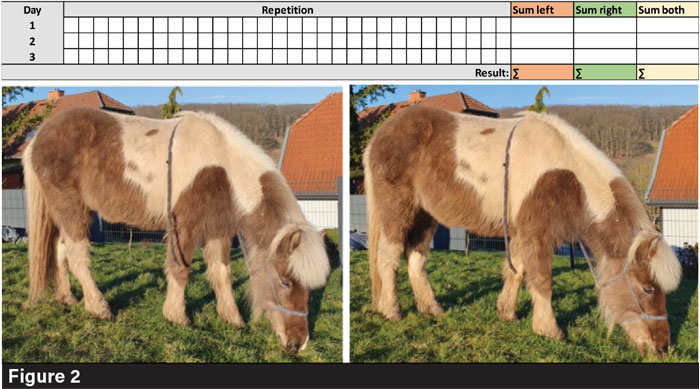
Recording grazing steps in a young horse at 30-second intervals over 10 minutes. Dr. Jenny Hagen
A horse’s laterality can be determined by the laterality index. This involves determining grazing stride preference and starting leg preference as indicators of motor laterality. For examination, every 30 seconds for 10 minutes on three different days, the leg placed forward during grazing is recorded and documented (Figure 2). In addition, starting leg preference is tested and written down five times in a row on 3 days (Figure 3).

Starting leg preference is tested and recorded five consecutive times over 3 days. Dr. Jenny Hagen
The preferred use of the sensory organs of one side of the face to explore new objects is assessed as an indicator of sensory laterality. Sensory laterality is documented over 3 days during the presentation of five new, different objects (Figure 4).

The preferred use of the sensory organs of one side of the face to explore new objects is assessed as an indicator of sensory laterality. Dr. Jenny Hagen
From these three tests, the mean laterality index is calculated:
LI = (∑ right - ∑ left)/(∑ left + ∑ right + ∑ both*) = (*not for start leg preference)
Regarding motor laterality (Figure 5), it’s been shown in large feral horse populations that haven’t been subject to the influence of human handling, that the proportion of horses with left and right handedness is balanced. Preferences for motor use of the left or right side of the body occur at the individual level. Only a few studies describe breed-specific differences. For example, Thoroughbreds have shown to have a preference for left-handedness (McGreevy et al. 2006). In general, the influence of the human interaction must always be considered in such studies. In most cases, the horse’s handling is from the left, which may also influence the development of left-sided handedness. What’s certain, however, is that the horse’s individual motor laterality increases with age.
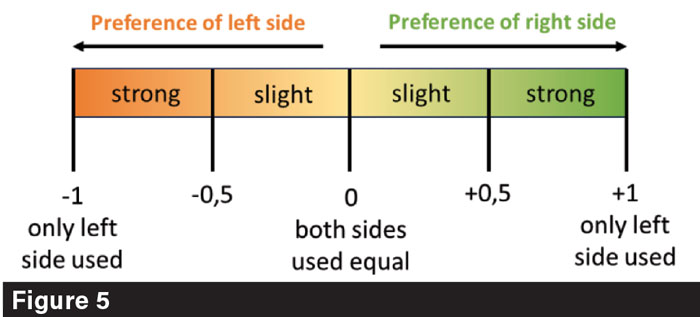
The Mean Laterality Index is calculated. Dr. Jenny Hagen
Research also shows a correlation between motor laterality and the personality or the predominant emotions of the respective horse. This is because the positive or negative emotions are also subject to lateralization of the cerebral hemispheres.
Studies show that horses with a right starting leg preference (right motor laterality) tend to be optimists, whereas horses with left starting leg preference (left motor laterality) appear to be pessimists. An increase in left sensory and motor laterality are demonstrated during stress (Marr et al. 2018).However, as with all scientific studies, exceptions prove the rule.
In general, motor laterality is evident in foals. Van Heel et al. examined 24 foals at 3, 15, 27 and 55 weeks of age (Kroekenstoel et al. 2006). In this study, 50% of the foals developed a grazing step preference, which led to the manifestation of a natural skewness in the locomotor system.
The uneven loading resulted in the development of uneven hooves. In particular, foals with long legs and short necks or heads were more prone to this development. This fact should be considered in the choice of genetic material for breeding.
Individual motor laterality was evident in young horses. Motor laterality in free trot and free jumping was tested on 17 healthy, but untrained warmbloods (Kroekenstoel et al. 2006). Significant laterality was visible in 24% of the 3-year-old horses. The occurrence of right-left differences in stride duration, stance phase duration, stride length, diagonal limb movement and length of limb pro- and retraction during swing phase, as well as bilateral limb loading in healthy, adult horses was demonstrated (McGreevy et al. 2006; Drevemo et al. 1980, 1987; Rehren et al. 2018).
Unilateral training increases the individual tendency. For example, a study of 30 horses used intensively for jumping and dressage over 8 years tested handedness during longeing and riding (Meij et al. 1980). In this study, 23 horses showed strong and stable lateral preference. The horses were subjected to special training to compensate for functional skewness, which resulted in a significant decrease in individual laterality.
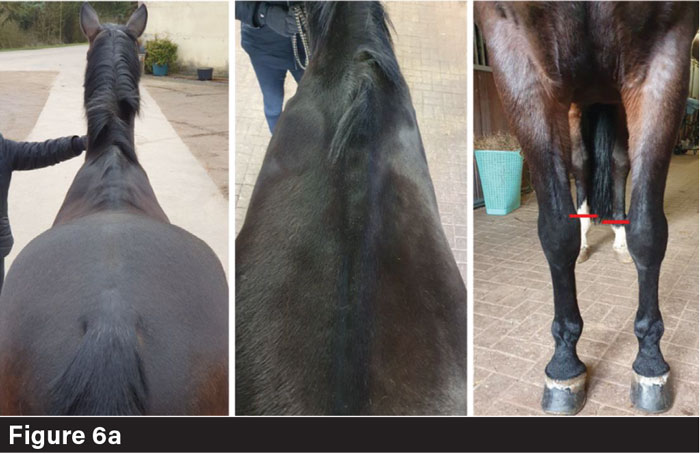
Skew horse with a steeper right front hoof and asymmetries in the proximal locomotor system. Dr. Jenny Hagen
This work shows that handedness can be reduced by adapted training, which is probably based on the change of muscle status and neuromuscular pathways. This is also shown for the effect of manual therapy (Maldonado et al. 2022; Haussler 2014; Faber et al. 2003). In one study, a reduced ability for lateral bending and rotation in the thoracic vertebrae of a horse was noted before treatment. After the first treatment, there was a significant improvement in mobility and symmetry. After 8 months these parameters were still better than before treatment. Our measurements show that the symmetry of the temporal parameters of the individual step phases can be improved more significantly by manual therapy than by shoeing alone (Figures 6a and 6b).
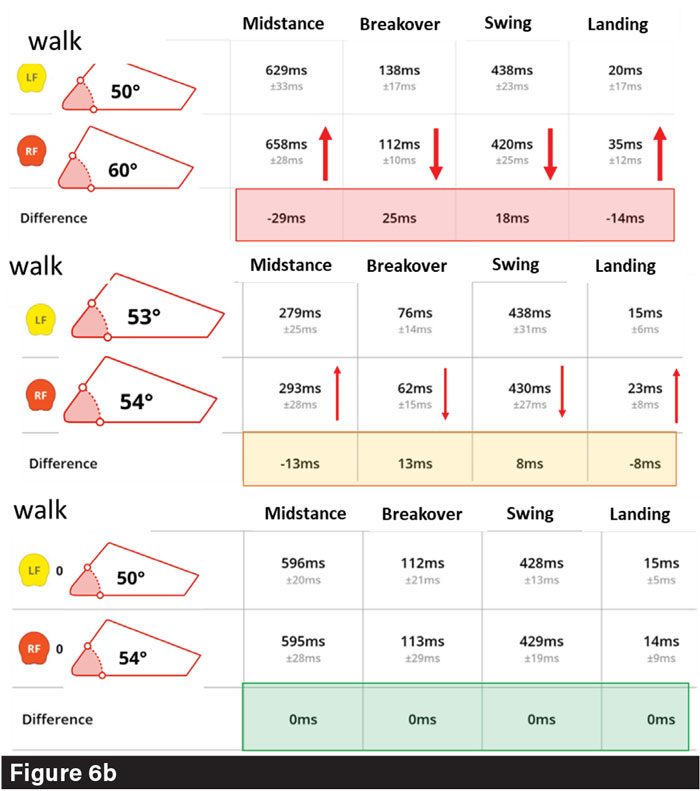
Time duration of midstance, breakover, swing phase and landing and the hoof angles of the left (yellow) and right (red) front hoof of a horse with uneven hooves, asymmetric shoulders and myofascial dysfunctions with the old shoes (upper row), after shoeing (middle row) and after manual therapy on the same day (lower row). Dr. Jenny Hagen
The optimization or change of the physiological, individual laterality isn’t achieved by passive manipulation of the locomotor system (binders, loop reins or weights on the limbs), but by changing the sensory input, the neuronal activity and processing, as well as symmetrical training of the musculature. Sensory laterality must be distinguished from motor laterality. In studies, 48 of 55 horses showed a sensory left preference. Right preference was found in five horses, one showed no preference and one changed preference (Farmer et al. 2010).
Again, the influence of human handling from the left side should be considered. However, a genetic determination cannot be dismissed and could provide a scientific explanation why horses often show more willingness for longeing on the left hand than on the right hand or prefer to approach strangers with the left side (Farmer et al. 2018). That’s why it’s recommended to initially interact with anxious horses from the left. With regard to social interaction, it’s been shown that agonistic confrontations with conspecifics are 68% left-sided and affiliative behaviors are 90% right-sided sensory (Farmer et al. 2010).
In particular, the use of the eyes of one side are subject to sensory laterality, which is because in the visual transmission of information, 80% of the information crosses between the cerebral hemispheres (Farmer et al. 2010). The left limbs, eyes and ears are primarily connected to the right hemisphere of the brain, while those on the right primarily connect with the left.
Motor and sensory laterality provides an indication of whether the horse tends to process information in the right or left hemisphere of the brain. The right hemisphere tends to be reactive, serving behaviors such as flight, global attention, withdrawal, control of new situations and stress processing. The left hemisphere is the proactive side, serving behaviors such as approach, control of routine situations, focused attention and learning. Thus, sensory laterality only indicates the specialization of the cerebral hemispheres for perception.
Horses that preferentially use the sensory organs of one side of the face to explore new objects have certain personality traits. There’s a scientific connection between emotionality and sensory laterality. Thus, the preferred use of the left sensory organs indicates a higher reactivity (readiness to flee), whereas the preferred use of the right sensory organs suggests a stronger proactivity (exploration/curiosity). These characteristics must be considered in training and especially in dealing with fearful horses. Through habituation and targeted behavioral training, sensory laterality also can be modified within limits.
Uneven Feet
Uneven front feet are the consequence of natural skewness and motoric laterality. Uneven weight-bearing causes unequal loading of the left and right side. The result is an adaption with structural and functional asymmetry. The main reasons for the development of uneven feet are a strong motor laterality in young horses, a significant skewness in the proximal locomotor system and a pain-associated relief posture due to orthopedic disorders at the distal limb. Usually, the more loaded hoof becomes wider and flatter, while the less loaded foot is narrow and steeper. However, the functional consequences aren’t as clear and generally applicable as in textbooks. There’s the assumption that the hoof angulation is associated with the shape of the flight arc in swing phase and with the breakover duration. Horses with a steep hoof angulation show a flat beginning of the curve of the flight arc with a late peak of maximum height at the end of the swing phase. Horses with flat, more acute hooves show an early peak height due to greater resistance to the ground because of the longer leverage at the toe. However, this assumption can’t be proven.
The author’s measurements show the shape and height of the flight arc isn’t dependent on hoof angulation. Even hooves with uneven dorsal wall angulations can show a symmetry in the height and shape of the flight arc. Or the other way around, horses with equal hooves show asymmetries in the quality of the flight arc. Muscle status and properties of the proximal locomotor system seem to have a higher influence on this parameter than hoof conformation. Moreover, the belief that steeper hooves show a faster breakover duration than acute angled hooves isn’t generally correct. In horses with uneven front hooves due to motoric laterality and natural skewness, the described statement is often right (Figure 7).
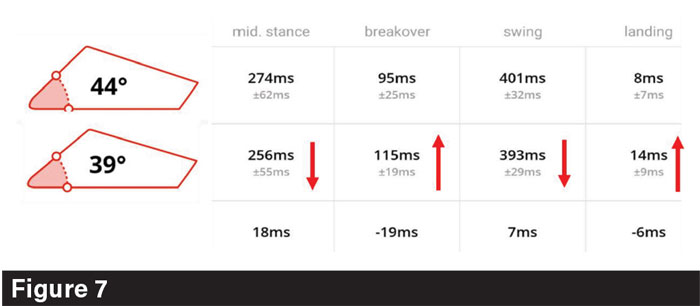
Timing parameters and hoof angulation of a horse with uneven feet due to significant laterality and natural skew. Dr. Jenny Hagen
The mechanical differences result in the steeper hoof being in an advantageous condition for breakover and thereby faster than the flat one. However, in horses with a pain-induced uneven load of the limbs, the affected side usually shows the steeper hoof with an increased breakover duration at the lame foot (Figure 8). The difference in functional asymmetries in horses with uneven feet must be considered in the development of the individual shoeing protocol. In horses with uneven feet due to motor laterality, an adaption (equalization) of the hoof angle can be aimed, if possible.
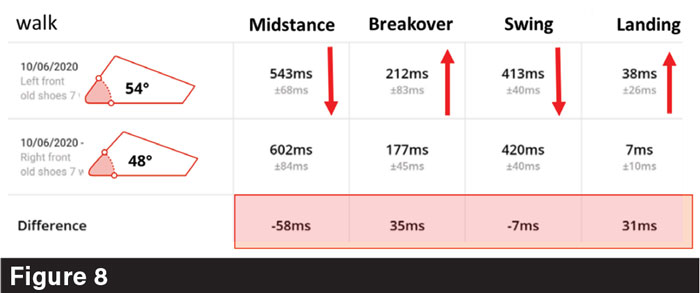
Timing parameters and hoof angulation of the left and right foot of a horse with a podotrochlosis and lameness at the left limb 2,5/5 AAEP. Dr. Jenny Hagen
As shown above, manual therapy and specific training can support and increase the effect of shoeing. If the heels of the steep hoof are shortened, it needs to be considered that the breakover duration of this foot increases dramatically. It’s strongly recommended to give the steeper hoof, after shortening the heels, a wide and significantly palmarly-placed breakover. This can be even greater than on the more acute angled hoof at which usually the toe is shortened, causing an eased breakover even without a strong toe modification in the shoe.
In horses with uneven feet due to pain-induced lameness, a distinct angle adaption between the uneven feet needs to be considered carefully and critically. In some cases, a change in angulation even causes more stress and strain on the diseased structure and increased functional asymmetry (Figure 9).
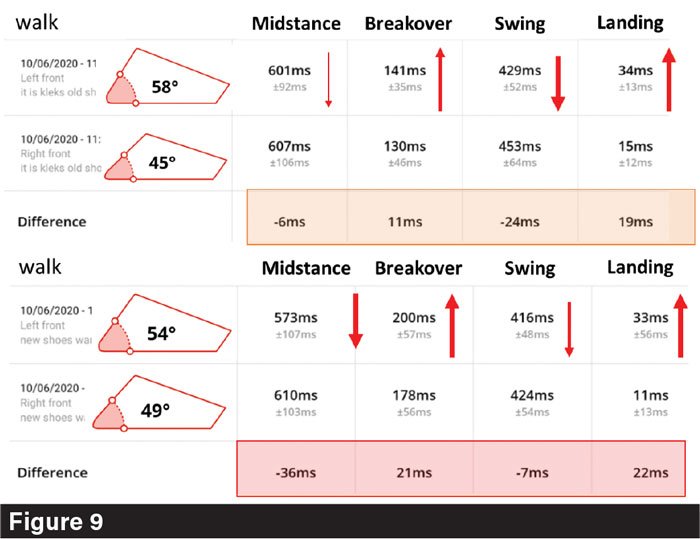
Horse with arthrosis at the left front foot before shoeing (upper row) and after with angle correction and insufficient toe modification to ease breakover at the steeper hoof (lower row). Dr. Jenny Hagen
Instead of adaption of the structural asymmetry between the front hooves, respect the conformation and aim for functional symmetry by shoe modification, pain relief and increase comfort.
In summary, natural skewness, sensory laterality and motor laterality are independent factors that should be considered in postural evaluation, handling, riding and training. It’s useful for every trainer, rider, farrier and therapist to know the motor and sensory laterality of each horse to better address its abilities and needs. Especially the motor laterality can be influenced and reduced by specific training and manual therapy intervention, which minimizes the development of natural skewness, especially in young horses.
Uneven feet are the consequence of skewness and motor laterality. It’s crucial to investigate the reason for uneven load of the front hooves and adapt the shoeing protocol not just to equalize the structural asymmetry, but more importantly to create and maintain a functional symmetry during locomotion.

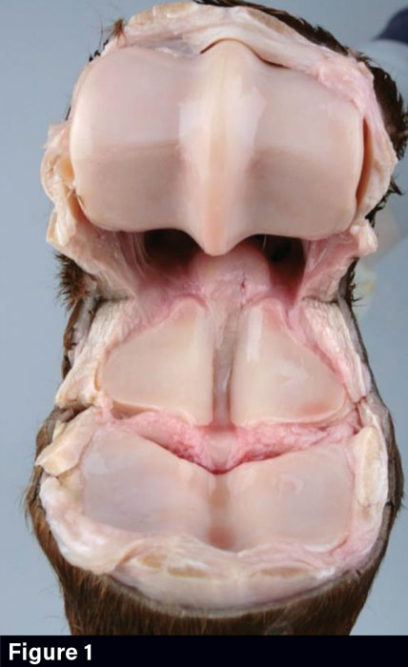
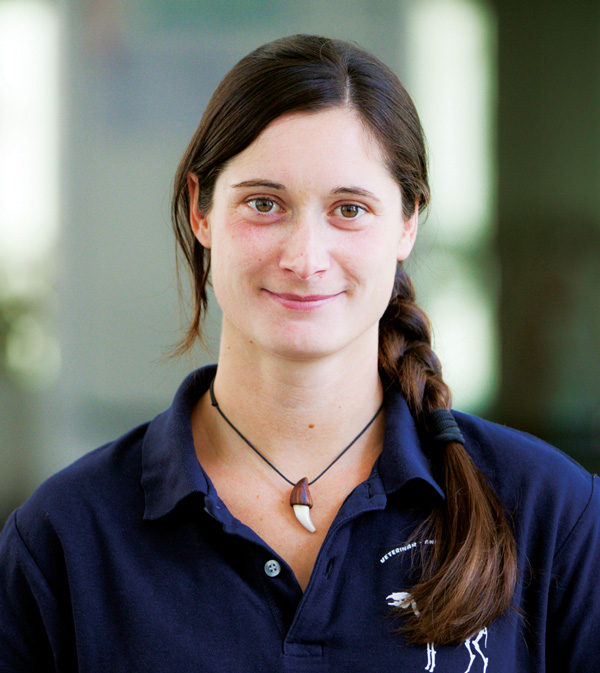






Post a comment
Report Abusive Comment